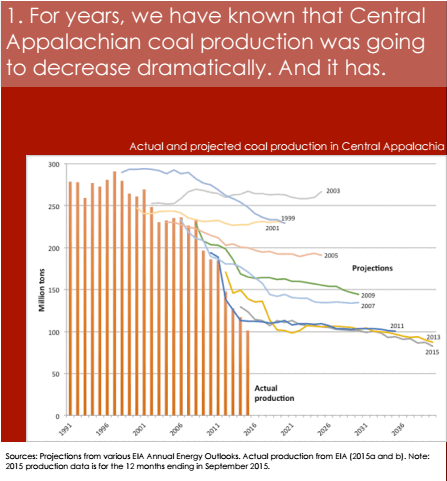Front Porch Blog
The new year brings more bad news for a battered industry
It probably comes as no surprise that, after the dismal year coal had in 2015, more hard times for the industry are ahead. Nowhere is the struggle more real than here in Central Appalachia.
The latest look into a window of coal’s burning house comes courtesy of Downstream Strategies. The West Virginia-based environmental consulting firm has been charting Central Appalachian coal’s decline for years and is urging policymakers to plan for a future in which coal is no longer king.
The group’s new white paper, creatively titled “All Of Our Eggs In One Basket?,” tells the story of Appalachian coal over the past few decades in five simple charts like the one above. It also considers how coal’s decline contributes to the budget deficits wracking West Virginia. In summary:
Future demand for Central Appalachian coal will likely continue to decline—primarily due to the increasing cost of mining thinner, harder-to-access coal seams and competition from cheaper natural gas, renewable energy, and energy efficiency improvements at homes and businesses. Future environmental regulations on coal mines and power plants, such as the federal Clean Power Plan, may further reduce demand for West Virginia coal.
For data related to regional coal production and projections, Downstream Strategies looked to the U.S. Energy Information Administration. Just today, that agency shared its own update on coal prices and production in 2015. While the main lesson from the chart above is probably that it’s best to be skeptical when it comes to EIA projections, the severity of the situation in Appalachia becomes even clearer when the region is viewed relative to other domestic coal reserves.
According to the EIA, the amount of coal produced in the Central Appalachian basin in 2015 was 40 percent below its annual average during the period from 2010 to 2014. Wherever coal is still competitive, less and less of it is coming from Central Appalachia.
Anyway, back to the Downstream Strategies report, which wraps up with yet another firm reminder that coal’s steep decline and its consequences are anything but unexpected. As the authors conclude:
For years, we have known that coal production was likely to drop significantly in southern West Virginia, and that coal production will likely continue to decline in the future. Now that these projections are coming true, the state is grappling with fewer jobs, bankrupt companies, and declining severance tax revenues.
Together, these present unprecedented challenges not just for southern West Virginia counties, but also for the state as a whole.
New approaches are needed.
When it comes to coal, the question for regional policymakers now is not so much how to make it better, but what to do when it gets even worse. If we may suggest a resolution for the new year: Don’t wait any longer. Recognize and respond to the realities of today’s energy market and the economic challenges facing the region.
Stay informed by subscribing to the Front Porch Blog.
PREVIOUS
NEXT

Leave a comment
Your email address will not be published. Required fields are marked *



Leave a Comment